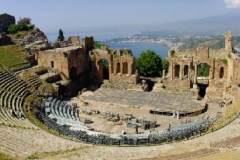Romeo and Juliet, Ballet of Rome
Mo | Tu | We | Th | Fr | Sa | Su |
Experience the timeless love story of Romeo and Juliet like never before, performed by the Ballet of Rome at the iconic Taormina Opera Festival in Sicily. Held at the spectacular Teatro Antico, this mesmerizing ballet production brings to life the passionate tragedy of Shakespeare’s beloved play. The company’s stunning choreography, accompanied by an enchanting musical score, will transport you to Verona, where the love between Romeo and Juliet unfolds amidst the fierce tension between their families. With beautiful sets, powerful performances, and a captivating atmosphere, the ballet showcases the intense emotions and dramatic moments that have made this story legendary. Whether you're a long-time fan of the classic tale or discovering it for the first time, this performance promises to deliver an unforgettable experience. Don't miss the chance to see this unforgettable production in the stunning surroundings of one of the world’s most breathtaking ancient theaters. Book your tickets now for an evening of passion, romance, and dramatic beauty!
Program and cast
Teatro Antico di Taormina
Ancient theatre of Taormina
Description
The ancient theatre (the teatro greco, or "Greek theatre") is built for the most part of brick, and is therefore probably of Roman date, though the plan and arrangement are in accordance with those of Greek, rather than Roman, theatres; whence it is supposed that the present structure was rebuilt upon the foundations of an older theatre of the Greek period. With a diameter of 120 metres (390 ft) (after an expansion in the 2nd century), this theatre is the second largest of its kind in Sicily (after that of Syracuse); it is frequently used for operatic and theatrical performances and for concerts. The greater part of the original seats have disappeared, but the wall which surrounded the whole cavea is preserved, and the proscenium with the back wall of the scena and its appendages, of which only traces remain in most ancient theatres, are here preserved in singular integrity, and contribute much to the picturesque effect, as well as to the interest, of the ruin. From the fragments of architectural decorations still extant we learn that it was of the Corinthian order, and richly ornamented. Some portions of a temple are also visible, converted into the church of San Pancrazio, but the edifice is of small size.

 EN
EN DE
DE IT
IT FR
FR ES
ES RU
RU JP
JP RO
RO
 Seating plan
Seating plan 

